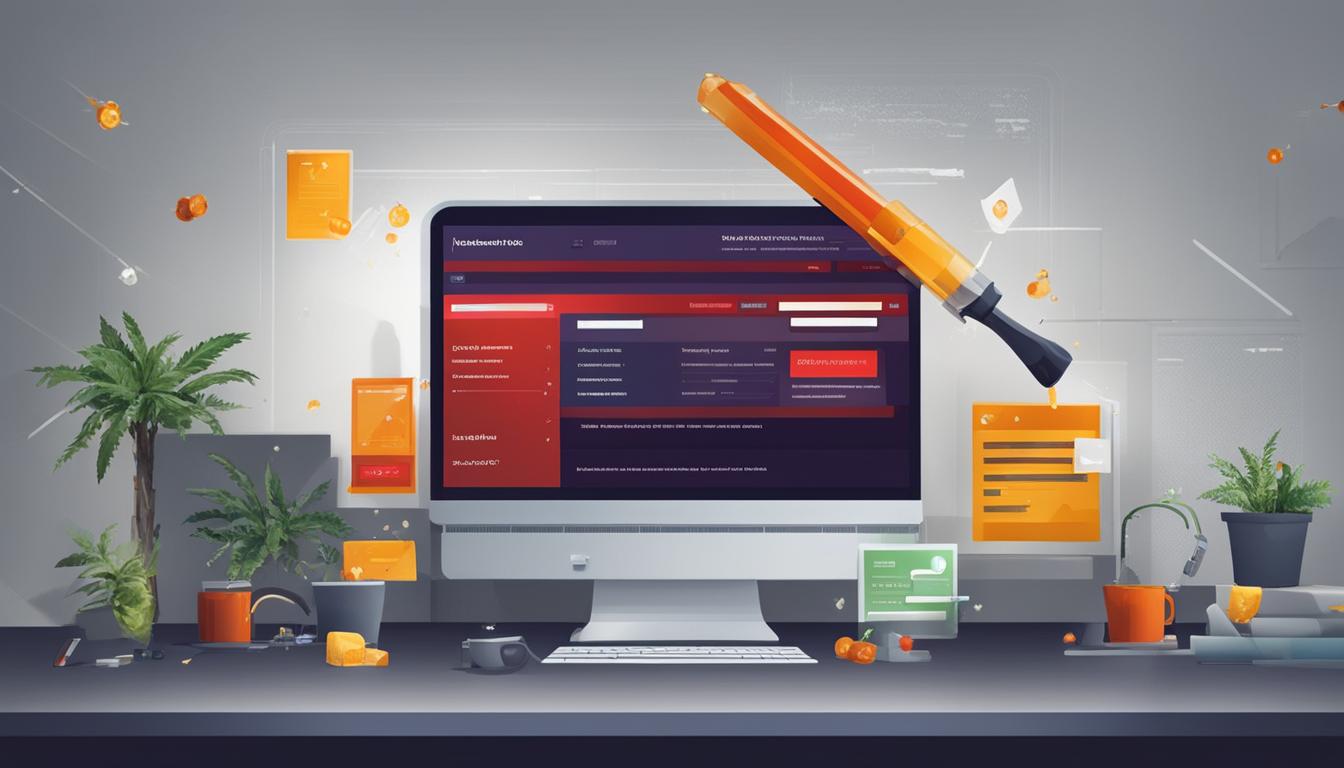Discover our detailed guide to mastering SEO poisoning techniques and shielding your site from harmful methodologies. In the current digital era, prioritizing your website’s security is critical. Individuals with harmful intentions continually create innovative ways to take advantage of weaknesses and alter search engine results for their gain. By learning about SEO poisoning and adopting essential protective measures, you can guarantee the safety and reliability of your digital footprint.
SEO poisoning, also known as black hat SEO techniques, involves deceptive practices used to hijack search engine results and lead unsuspecting users to malicious websites. These tactics include injecting malicious code, creating fake websites, and exploiting search engine algorithms. The consequences of SEO poisoning can range from damaging your website’s reputation to infecting users’ devices with malware.
Key Takeaways:
- SEO poisoning involves manipulating search engine rankings to redirect users to harmful websites.
- Attackers use various tactics, such as injecting malicious code and creating fake websites, to exploit vulnerabilities.
- Examples of SEO poisoning include manipulating searches related to pharmaceutical products and celebrity news.
- To protect your website, educate users, monitor search engine results, and implement secure coding practices.
- Collaboration between cybersecurity experts and SEO professionals is essential for a robust security foundation.
What is SEO Poisoning?
SEO poisoning, also known as search poisoning, refers to the deceptive and malicious tactics employed by individuals or groups to manipulate search engine rankings. These black hat SEO techniques exploit vulnerabilities in search engine algorithms, with the ultimate goal of directing unsuspecting users to harmful websites or malicious content.
Attackers engage in SEO poisoning by injecting malicious code, creating fake websites, or utilizing other manipulative strategies that trick search engines into ranking their content higher in search results. By capitalizing on popular search keywords and topics, they aim to attract users to click on their links or visit compromised websites, leading to potential data breaches, malware infections, or other harmful consequences.
Search engine algorithms are designed to provide users with relevant and trustworthy information, but SEO poisoning subverts this system to serve malicious intentions. It is crucial for website owners and SEO professionals to understand this threat and take proactive measures to safeguard their online presence and protect users from falling victim to SEO poisoning.
Key Characteristics of SEO Poisoning:
SEO poisoning involves several key characteristics that distinguish it from legitimate search engine optimization practices. These include:
- Exploiting vulnerabilities: Attackers target weaknesses in search engine algorithms to manipulate search results and gain visibility for their malicious content.
- Injection of malicious code: SEO poisoning often involves injecting malicious scripts or code onto legitimate websites, compromising their integrity and redirecting users to harmful websites.
- Creation of fake websites: Attackers create websites that appear legitimate but are designed to deceive users and distribute malware or steal personal information.
The Impact of SEO Poisoning:
SEO poisoning can have severe consequences for individuals and organizations alike. It not only compromises website security but also undermines user trust in search engine results. Users who fall victim to SEO poisoning may unknowingly expose their personal information, fall prey to financial scams, or have their devices infected with malware. In addition, businesses may suffer reputational damage and loss of customer trust if their website becomes associated with malicious activities.
Preventing and mitigating SEO poisoning requires a comprehensive approach that encompasses both technical measures and user awareness. By implementing robust website security practices, regularly monitoring search engine rankings, and educating users about the risks, website owners can protect themselves and their users from the detrimental effects of SEO poisoning.
Examples of SEO Poisoning
SEO poisoning can manifest in various forms, targeting different industries and taking advantage of popular topics to deceive users. By understanding these examples, we can better protect our websites from falling victim to SEO poisoning attacks.
Pharmaceutical Poisoning
One common form of SEO poisoning involves the manipulation of searches related to pharmaceutical products. Malicious actors create websites that appear legitimate and offer counterfeit or unregulated medications. By optimizing their content with keyword-rich pages, they manipulate search engine rankings and trick users into accessing these dangerous websites. This not only puts users’ health at risk but also damages the reputation and credibility of legitimate pharmaceutical companies.
Celebrity News
Another tactic used in SEO poisoning is exploiting public interest in celebrities. Malicious actors create fake websites that appear to provide exclusive news, gossip, or even leaked content about popular figures. By leveraging popular search terms and implementing black hat SEO techniques, these websites rank high in search engine results. When users visit these websites, they may unknowingly download malware or become victims of identity theft.
Seasonal Scams
During holidays or specific seasons, malicious actors take advantage of the increased online shopping and festive activities by creating fake websites offering seasonal discounts or holiday-related content. These websites may appear legitimate, with attractive offers and visually appealing designs. However, they aim to deceive users into providing personal information or making purchases on unsecure platforms. These seasonal scams can result in financial loss, compromised personal data, and reputational damage for both users and legitimate businesses.
| Examples of SEO Poisoning | Description |
|---|---|
| Pharmaceutical Poisoning | Manipulation of searches related to pharmaceutical products to deceive users into accessing harmful or counterfeit medication websites. |
| Celebrity News | Exploiting public interest in celebrities to spread malware or steal personal information through fake websites offering exclusive news or leaked content. |
| Seasonal Scams | Creating fake websites with attractive seasonal discounts to deceive users into providing personal information or making purchases on unsecure platforms. |
Steps to Avoid SEO Poisoning
Protecting your website from SEO poisoning requires a proactive approach and a combination of strategies. Here are some essential steps you can take to safeguard your website:
Educate Users
One of the first lines of defense against SEO poisoning is user education. Raise awareness among your website visitors about the dangers of clicking on suspicious links or visiting unfamiliar websites. Promote safe browsing habits and encourage them to report any suspicious activities they encounter. By educating users, you can minimize the risk of falling victim to SEO poisoning.
Monitor Search Engine Results
Regularly monitoring your website’s search engine rankings is crucial for detecting any signs of SEO poisoning. Keep an eye out for sudden drops in rankings or unexpected fluctuations, as these could be indicators of malicious activities. By staying vigilant, you can take immediate action to address any potential threats and prevent further damage.
Purchase Similar Domains
Malicious actors may try to exploit your brand’s reputation by purchasing similar domains and creating fake websites. To mitigate this risk, consider purchasing similar domains to prevent impersonation. By securing these domains, you can protect your brand image and reduce the likelihood of users falling into the trap of SEO poisoning.
Cautious Linking and Ethical SEO
When linking to external websites, exercise caution and verify the credibility of the destination. Avoid linking to suspicious or untrusted sources that may engage in black hat SEO techniques. Instead, focus on ethical SEO practices that prioritize user experience and genuine content. By practicing cautious linking and ethical SEO, you can maintain the integrity of your website and minimize the risk of SEO poisoning.
Implement SSL Certificates and Stay Updated
Enhance the security of your website by implementing SSL certificates, which encrypt data transmitted between your website and visitors. This provides an additional layer of protection against potential SEO poisoning attacks. Additionally, staying updated with the latest SEO trends and security threats is crucial. Regularly monitor industry news and seek professional guidance to ensure that your website remains secure and stays ahead of evolving threats.
| Steps to Avoid SEO Poisoning |
|---|
| Educate Users |
| Monitor Search Engine Results |
| Purchase Similar Domains |
| Cautious Linking and Ethical SEO |
| Implement SSL Certificates and Stay Updated |

Collaboration between Cybersecurity and SEO Professionals
Protecting website security is a shared responsibility that requires collaboration between cybersecurity experts and SEO professionals. By combining our knowledge and expertise, we can establish a strong security foundation while optimizing websites for search engines.
When it comes to website security, cybersecurity experts play a critical role in implementing robust security measures. This includes ensuring secure coding practices are followed, using secure content management systems (CMS) and plugins, and conducting regular security audits to identify and address vulnerabilities.
On the other hand, SEO professionals can contribute by staying updated on the latest security threats and trends. By monitoring suspicious activities related to SEO, such as unexpected drops in search engine rankings or unusual backlinks, we can detect and prevent SEO poisoning attempts. Additionally, incorporating secure coding practices and implementing proper authentication and authorization mechanisms can help safeguard websites from malicious attacks.
Together, we can create a secure online environment by implementing measures such as regular security audits, monitoring for suspicious activities, and validating user-generated content. By working hand in hand, cybersecurity experts and SEO professionals can protect websites from SEO poisoning and ensure the safety and trust of our online audience.
| Collaboration between Cybersecurity and SEO Professionals |
|---|
 |
Robust Website Security
Ensuring robust website security is essential in protecting against the ever-evolving threat of SEO poisoning. By implementing a combination of secure coding practices, using a secure content management system (CMS), regularly updating software and plugins, and utilizing web application firewalls, you can fortify your website’s defenses against potential attacks.
Secure Coding Practices
Implementing secure coding practices is crucial for building a resilient website. By incorporating measures such as input validation, proper authentication and authorization mechanisms, and effective error handling, you can mitigate vulnerabilities that can be exploited by malicious actors. It’s also important to utilize trusted libraries and frameworks to reduce the risk of security breaches.
Secure CMS and Regular Updates
Choosing a secure CMS is vital for website security. Evaluate the security features of different CMS options, including the developer community, regular updates, authentication and authorization capabilities, and vulnerability reporting. Additionally, regularly updating your CMS and plugins with the latest security patches is crucial to avoid potential vulnerabilities.
Web Application Firewalls
Implementing web application firewalls (WAFs) adds an extra layer of protection to your website. WAFs analyze and filter incoming traffic, blocking suspicious or malicious requests, including those related to SEO poisoning. They can help detect and prevent attacks, such as SQL injection and cross-site scripting, and protect your website and visitors from potential harm.
| Benefits of Robust Website Security | Actions |
|---|---|
| Protection against SEO poisoning | Implement secure coding practices |
| Reduced risk of data breaches | Choose a secure CMS |
| Enhanced user trust | Regularly update software and plugins |
| Prevention of website defacement | Utilize web application firewalls |
Investing in robust website security not only protects your website from SEO poisoning but also reduces the risk of other security breaches, enhances user trust, and prevents website defacement. By implementing secure coding practices, using a secure CMS, regularly updating software and plugins, and leveraging web application firewalls, you can establish a strong defense against potential threats and ensure the integrity of your website.

Secure CMS Comparison
| Secure CMS | Developer Community | Regular Updates | Authentication and Authorization | Data Handling Practices | Vulnerability Reporting and Response |
|---|---|---|---|---|---|
| WordPress | Active and extensive community | Frequent updates addressing security issues | Robust authentication and authorization features | Follows best practices for data handling | Efficient reporting and prompt response to vulnerabilities |
| Joomla | Large and dedicated community | Regular updates improving security measures | Advanced authentication and authorization options | Adheres to secure data handling protocols | Timely response to reported vulnerabilities |
| Drupal | Active and committed community | Frequent security updates | Granular authentication and authorization controls | Strong focus on data security | Prompt resolution of reported vulnerabilities |
By prioritizing security in your choice of CMS and plugins, regularly updating them, and carefully evaluating the security features they offer, you can create a robust website environment that minimizes the risk of SEO poisoning and other cyber threats.
Perform Regular Security Audits
Regular security audits are essential to maintaining a secure and protected website. By conducting these audits, we can identify potential vulnerabilities, review website code, and monitor server settings to ensure the integrity of our online presence. Auditing our security measures on a regular basis allows us to proactively address any weaknesses or gaps that could leave us susceptible to SEO poisoning attacks.
During a security audit, we carefully examine our website’s code to identify any potential flaws or vulnerabilities that could be exploited by malicious actors. This includes reviewing the codebase, configurations, and server settings to ensure that they meet the latest security standards. By doing so, we can discover and address any security vulnerabilities before they are exploited by attackers.
In addition to code review, regular security audits also involve monitoring server settings. This is crucial because server settings play a significant role in website security. By monitoring server settings, we can ensure that our website is configured correctly and that all necessary security measures, such as firewalls and access controls, are in place. Any abnormalities or misconfigurations can be addressed promptly to reduce the risk of SEO poisoning attacks.
Performing regular security audits is an ongoing process that helps us maintain a strong defense against SEO poisoning. By identifying vulnerabilities, reviewing website code, and monitoring server settings, we can take proactive measures to protect our website and safeguard our online presence from malicious actors.

Monitoring SEO Activities to Detect and Prevent SEO Poisoning
When it comes to safeguarding our website from SEO poisoning, proactive monitoring of SEO activities plays a critical role. By diligently observing and analyzing the performance of our website in search engine results, we can quickly identify any abnormal SEO patterns that may indicate potential SEO poisoning attempts.
One of the key indicators to monitor is unexpected drops in search engine rankings. If our website’s ranking suddenly plummets or shows inconsistent performance, it could be a sign of SEO poisoning. Additionally, keep an eye out for keyword stuffing, which involves cramming excessive keywords into the website’s content unnaturally. This practice is often employed by attackers to manipulate search engine algorithms and boost rankings.
Another red flag to watch for are unexpected redirects. If users are being redirected to irrelevant or suspicious websites without their consent, it may be a clear indication of SEO poisoning. Unusual backlinks, especially those originating from dubious sources or unrelated websites, can also be indicative of malicious activity.
By diligently monitoring these SEO activities and promptly addressing any abnormalities, we can effectively detect and prevent SEO poisoning, safeguarding our website and online presence.
| Indicators of SEO Poisoning | Actions to Take |
|---|---|
| Unexpected drops in search engine rankings | Investigate and analyze the cause, such as keyword stuffing or black hat SEO techniques. Take necessary steps to rectify the issue and improve website performance. |
| Keyword stuffing in website content | Review the website’s content to ensure it is optimized with relevant keywords but maintains a natural flow. Remove any unnecessary or redundant keywords. |
| Unexpected redirects | Inspect the website’s code, plugins, and server settings to identify any malicious code or unauthorized redirects. Remove and secure the affected sections. |
| Unusual backlinks from dubious sources | Regularly review and analyze the website’s backlink profile. Disavow or remove any backlinks from suspicious or irrelevant websites. |
Validate User-Generated Content
In order to prevent the injection of malicious links or code, it is crucial to implement validation and filtering mechanisms for user-generated content on your website. This will help maintain a secure environment and protect against SEO poisoning attempts. There are several effective methods and tools that can be used to ensure the integrity of user-generated content.
The Role of CAPTCHAs
CAPTCHAs (Completely Automated Public Turing tests to tell Computers and Humans Apart) are widely recognized as an effective defense against automated bots and malicious actors. By implementing CAPTCHAs, you can require users to complete simple tasks or solve puzzles to prove their human identity before submitting content. This helps filter out automated spam and reduces the risk of SEO poisoning through user-generated content.
Moderation Tools for Content Review
Having a robust moderation system in place is essential to validate user-generated content. Moderation tools allow you to review and approve content before it goes live on your website. This enables you to identify and remove any potentially harmful or suspicious content, preventing SEO poisoning attempts. It is important to establish clear guidelines and policies for user-generated content to ensure a safe and secure online environment.
Content Filtering for Increased Security
Implementing content filtering solutions can provide an additional layer of protection against SEO poisoning. Content filtering tools allow you to define specific rules and filters to automatically detect and remove content that may contain malicious links or code. By regularly updating and fine-tuning these filters, you can ensure that user-generated content is thoroughly screened and prevent any potential SEO poisoning attacks.
| CAPTCHAs | Moderation Tools | Content Filtering |
|---|---|---|
| Effective defense against automated bots and malicious actors | Review and approve content before publishing | Detect and remove potentially harmful content |
| Require users to complete tasks to prove human identity | Identify and remove suspicious or harmful content | Define rules and filters to automatically detect malicious content |
| Reduces the risk of SEO poisoning through user-generated content | Establish clear guidelines and policies for content | Thoroughly screen user-generated content |
By implementing effective validation and filtering mechanisms, such as CAPTCHAs, moderation tools, and content filtering, you can minimize the risk of SEO poisoning through user-generated content. These measures help maintain a secure website environment and protect your online presence from malicious attacks.
Detecting and Mitigating SEO Poisoning
SEO poisoning can have severe consequences for websites and online users. However, with the right tools and strategies, we can detect and mitigate the impact of these malicious attacks. In this section, we will explore various techniques and practices that can help identify SEO poisoning attempts and minimize their effects on your website’s search engine rankings and overall reputation.
Typosquatting Detection Tools
Typosquatting is a common technique used in SEO poisoning, where attackers register domain names that are similar to popular websites. These deceptive domains can trick users into visiting malicious websites or downloading infected files. To combat this, several typosquatting detection tools are available in the market. These tools analyze domain names and identify potential typosquatting attempts, allowing website owners to take necessary action to protect themselves and their users.
| Tool | Description |
|---|---|
| BrandProtect | A comprehensive typosquatting detection platform that scans the internet for potential variations of your domain name and alerts you of any suspicious activity. |
| dnstwist | An open-source tool that generates a list of potential typosquatting domains based on your input domain name, helping you proactively identify and mitigate typosquatting attempts. |
| DomainGuardian | A domain monitoring and typosquatting detection tool that provides real-time alerts and reports on potential threats to your domain name. |
Indicators of Compromise (IOC)
Indicators of Compromise (IOC) are signs that your website may have been compromised or injected with malicious content. These indicators can include unexpected changes in search engine rankings, sudden increases in traffic, or the presence of suspicious files or code on your server. By regularly monitoring and analyzing these indicators, you can detect SEO poisoning attempts early and take immediate action to mitigate the impact.
Quote: “The key to effective threat detection is to establish a baseline of what is normal for your website and be alert to any deviations from that baseline.” – Cybersecurity Expert
Endpoint Detection and Response (EDR)
Endpoint Detection and Response (EDR) solutions can play a crucial role in identifying and mitigating SEO poisoning attempts. These advanced security tools monitor activities on endpoint devices, such as computers and servers, to detect any suspicious behavior or malware infections. By analyzing network traffic, file changes, and system events, EDR solutions can identify potential SEO poisoning attacks and trigger an immediate response to contain and neutralize the threat.
By leveraging the power of typosquatting detection tools, regularly monitoring indicators of compromise, and implementing endpoint detection and response solutions, website owners can take proactive steps to detect and mitigate SEO poisoning. These practices, coupled with other security measures mentioned earlier in this article, can help safeguard your website and maintain its integrity in the face of evolving cyber threats.
Conclusion
In conclusion, preventing SEO poisoning is a collaborative effort that requires the expertise of both cybersecurity experts and SEO professionals. By working together, we can protect websites and users from the harmful effects of SEO poisoning attacks.
Regular security audits are essential to identify vulnerabilities and address them promptly. By staying vigilant and educating users about the risks, we can create a safer online environment.
Implementing secure coding practices, using a secure content management system, and regularly monitoring for suspicious activities are crucial steps in preventing SEO poisoning. Additionally, staying updated on the latest security trends and seeking professional help when needed will help us maintain a secure online presence.
FAQ
What is SEO poisoning?
SEO poisoning is a deceptive technique used by malicious actors to manipulate search engine rankings and direct users to harmful websites. It involves manipulating search engine results by exploiting vulnerabilities in search algorithms.
What are some examples of SEO poisoning?
Examples of SEO poisoning include manipulating searches related to pharmaceutical products, exploiting public interest in celebrities to spread malware, and creating fake websites offering seasonal discounts or holiday-related content.
How can I protect my website from SEO poisoning?
To protect your website from SEO poisoning, it is important to educate users about the risks, regularly monitor search engine rankings for anomalies, purchase similar domains to prevent impersonation, exercise caution when linking to external websites, practice ethical SEO techniques, implement SSL certificates for added security, stay updated on SEO trends and security threats, and seek professional help when needed.
How can collaboration between cybersecurity experts and SEO professionals help protect against SEO poisoning?
Collaboration between cybersecurity experts and SEO professionals is crucial to establish a strong security foundation while optimizing a website for search engines. It involves implementing robust website security measures, secure coding practices, using secure content management systems and plugins, conducting regular security audits, and monitoring for suspicious activities that may indicate SEO poisoning attempts.
What are some essential steps for robust website security?
Robust website security includes implementing secure coding practices, regularly updating software and plugins, and using web application firewalls to detect and prevent attacks. Choosing a secure content management system and regularly updating it with the latest security patches is also crucial for website security.
What are secure coding practices?
Secure coding practices involve practices such as input validation to prevent attacks like SQL injection and cross-site scripting, avoiding hardcoding sensitive information, implementing strong authentication and authorization mechanisms, proper error handling, and using trusted libraries and frameworks to reduce vulnerabilities.
How can I ensure the security of my content management system and plugins?
It is important to evaluate the security of a content management system (CMS) based on factors like the developer community, regular updates, authentication and authorization capabilities, data handling practices, and vulnerability reporting and response. When selecting plugins, consider the source, user ratings and reviews, regular updates, compatibility, and requested permissions.
Why are regular security audits important?
Regular security audits help identify potential vulnerabilities or weaknesses that could lead to SEO poisoning. By reviewing website code, configuration files, and server settings, organizations can proactively address security gaps and ensure the integrity of their SEO efforts.
How can I monitor for suspicious activities related to SEO poisoning?
Vigilant monitoring of SEO-related activities is crucial for detecting and preventing SEO poisoning attempts. Activities such as sudden drops in search engine rankings, keyword stuffing, unexpected redirects, and unusual backlinks are indicators of potential SEO poisoning. Prompt investigation and addressing these anomalies will help prevent further damage.
How can I validate user-generated content to prevent SEO poisoning?
Implementing validation and filtering mechanisms for user-generated content is essential to prevent the injection of malicious links or code. CAPTCHAs, moderation tools, and content filtering can help maintain a secure website environment and protect against SEO poisoning attempts.
How can I detect and mitigate SEO poisoning?
Detecting SEO poisoning can be challenging, but using typosquatting detection tools, indicators of compromise (IOC) lists, and endpoint detection and response (EDR) solutions can help identify potential attacks. Monitoring for suspicious URLs, analyzing user and client history, and promptly addressing any SEO poisoning attempts are crucial for mitigating the impact of SEO poisoning.










